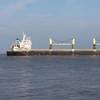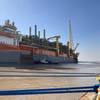Orient Overseas International (OOIL) and its container unit OOCL have a good track record for above-average profits in a challenging market and a reputation for being a very well-run company, earning the moniker “The Perfect Bride” by Drewry Maritime Financial Research.
Retaining the management team, processes and systems is a wise move and could be of enormous value to Cosco Shipping Holdings (Cosco), Drewry said.
OOCL has an owned-fleet of 66 containerships aggregating approximately 440,000 teu. It is a young and modern fleet with an average age of 7.1 years and average nominal capacity of 6,600 teu. It is introducing its first 21,000 teu vessel with five more to deliver and options for another six which it could easily exercise.
Based on existing fleet and orderbooks the combined Cosco-OOCL entity would become the world’s third largest container carrier, overtaking its partner in the Ocean Alliance, CMA CGM (see table).
Cosco itself has a large orderbook, including newbuilds inherited from last year’s merger with China Shipping Container Lines. As such, it will have little requirement to order any more new ships in an already over-supplied market.
OOIL/OOCL has interests in four terminals: 100 percent owned facilities in Long Beach in the U.S. and Kaohsiung, Taiwan, and minority stakes (20 percent) in two Chinese terminals (Tianjin and Ningbo).
Operationally, fitting OOCL into the bigger company should not be too difficult as both OOCL and Cosco already belong to the Ocean Alliance (alongside CMA CGM and Evergreen) that operates mainly in the East-West container trades. OOCL is not a major player in the North-South tradelanes that fall outside of the scope of the carrier group.
The biggest impact will be felt in Intra-Asia, where both carriers already have a large presence, while the footprint in the Asia to Middle East trade will also rise significantly.
From a marketing perspective the acquisition of OOCL will enable Cosco to broaden its customer base, having previously being perceived, rightly or wrongly, as China-centric. OOCL’s reputation and history with global shippers will provide Cosco with an inroad to a wider selection of big Western shippers with volume.
As far as terminal ownership is concerned, in Ningbo, Cosco is also a shareholder in the same terminal as OOCL so this is a simple consolidation. In Tianjin, Cosco already has stakes in two terminals, neither of which are the same as the terminal in which OOCL has a stake, and so some ownership consolidation may take place here. This may involve Cosco taking an interest at the port authority level of ownership, as it has done in, for example, Qingdao.
OOCL’s Long Beach operation is undergoing a very large re-development that will see the existing one-berth Long Beach Container Terminal at Pier F closed and the three-berth Middle Harbor Redevelopment Project (MHRP) replace it. Phase I of MHRP went live in April 2016 and has since been in full operation; Phase II is expected to be operational at the end of 2017.
Cosco already has two terminals in LA/LB so this will be a third and by 2020 these three terminals will account for nearly 30 percent of the capacity of LA/LB. So while the capacity in LA/LB remains physically fragmented, the ownership is at least consolidating.
In Kaohsiung, Cosco has a stake in one terminal (along with China Merchants, Yang Ming, NYK and Ports America). The OOCL terminal is a different one.
Cosco Shipping Ports (CSP) is reportedly acquiring a 15 percent stake in SIPG from Shanghai Tongsheng Investment and this would make CSP the third largest shareholder in SIPG. This is further evidence of the agglomeration of the Chinese state-owned enterprises involved in the port sector. SIPG’s involvement in the OOCL deal is therefore not a left-field move but very much further evidence of the consolidation and intertwining of Chinese-owned port sector activity.
Earlier reports suggested the valuation of the deal would be closer to USD 4 billion, which would be similar to what CMA CGM paid for NOL/APL. That always seemed undervalued considering OOIL’s better financial performance and reputation, plus the improving market outlook.
However, at $6.3 billion the price does seem a bit steep. According to Drewry Maritime Financial Research, OOIL’s book value stood at $4.5 billion based on FY16 numbers, meaning OOIL was able to extract a sizeable premium.
Regulatory: any likely obstacles? The simple answer is that we don’t know, but recent container M&A such as Maersk Line’s recent takeover of Hamburg Süd and the proposed ONE merger of Japanese carriers have all encountered minor issues so the possibility of some conditions being applied by non-Chinese authorities cannot be entirely discounted.












